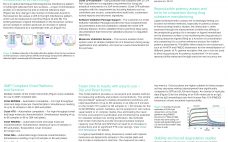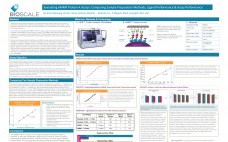Using the label-free optical technique of Bio-Layer Interferometry (BLI), the Octet platform provides real-time analysis of molecular interactions. It relies on the robust and easy-to-use Dip and Read™ format, which provides faster time to results relative to technologies like ELISA and SPR. It also operates in a fluidics-free format, thereby minimizing the complexity in analyte detection by fluidics-based technologies like SPR. It provides high-throughput analysis, with the option of analyzing to 96 samples simultaneously, thereby increasing analytical productivity. It has…
Lab Products & Equipment
Cookie Cutter Proteolysis: Achieving Reproducible, Efficient Digestions for Proteomic Workflows
Cookie Cutter Proteolysis: Achieving Reproducible, Efficient Digestions for Proteomic Workflows  Protein sample preparation workflows for mass spectrometric analysis that involve proteolysis are often labor-intensive, time consuming and user dependent. These workflows often involve digestion, solid phase extraction, drying, and re-suspension prior to reversed phase separation into the mass spectrometer. The introduction of variability at many of these steps hinders discovery initiatives as well as the ability to convert these discoveries into viable assays.  Recently, an automated protein digestion…
Evaluating AMMP Protein A Assays: Comparing Sample Preparation Methods, Ligand Performance & Assay Performance
Regulations governing the production of biopharmaceuticals require high levels of purity for processes utilizing Protein A affinity chromatography. It has been shown that Protein A in the presence of IgG forms a PA/IgG complex that interferes in the traditional immunoassay format for detecting Protein A. In this work we evaluated the AMMP Protein A Assay using two popular sample preparation methods to dissociate the ProteinA/IgG complex. The AMMP assay was also tested with Protein A ligands from multiple sources including…
A Single-Use Bioreactor for Both Cell and Microbial Cultures: A Dream Becomes Reality
Application of single-use equipment is common practice in the biopharmaceutical industrial and academic field. Compared to the traditional glass or stainless steel bioreactors, single-use bioreactors offer clear advantages: a quicker turnaround time; minimal utilities required; greatly reduced risk of cross contamination; more operational flexibility; reduced validation requirements. However, until recently, single-use bioreactors have a restricted application, only to animal cell cultures due to limitations in mixing and mass-transfer. As single-use technology not only has significant benefits for cell culture processes,…
Optical Oxygen and pH Sensors for Monitoring Biofermentation Processes
Advances in high-performance sensor materials and optoelectronics have enabled optical sensors for use in markets including the life sciences, environmental, food and beverage, process control and biotechnology. Compared with traditional electrochemical sensing techniques such as galvanic, paramagnetic and fuel cell sensors, these optical sensors can be made in small and customizable form factors such as probes and self-adhesive patches. The sensors also have fast response, provide long-term stability and are chemically inert. This experiment demonstrates the viability of optical sensors…




